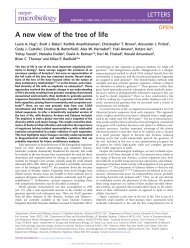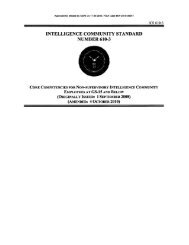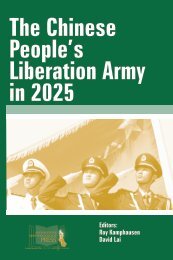The Joint Force in a Contested and Disordered World
JCS-JOE-2035
JCS-JOE-2035
Create successful ePaper yourself
Turn your PDF publications into a flip-book with our unique Google optimized e-Paper software.
encourage current allies <strong>and</strong> partners to pursue unilateral military modernization efforts or<br />
explore alternative alliances <strong>and</strong> partnerships.<br />
<strong>The</strong> emergence of new partnerships. Many nations, <strong>in</strong>clud<strong>in</strong>g the United States, may turn to<br />
“nontraditional” partnerships with a wide array of actors to <strong>in</strong>clude self-govern<strong>in</strong>g ethnic<br />
groups, non-governmental organizations, mult<strong>in</strong>ational corporations, <strong>and</strong> perhaps even<br />
friendly local militia groups. <strong>The</strong> search for unanticipated <strong>and</strong> atypical partners will likely be<br />
a common theme, particularly <strong>in</strong> the early phases of future conflicts.<br />
In an <strong>in</strong>creas<strong>in</strong>gly multipolar world, the United States is likely to encounter potential adversaries<br />
with the capacity to devote significant resources to military spend<strong>in</strong>g <strong>and</strong> the development of their<br />
own security partnerships. However, with energy prices expected to rema<strong>in</strong> low for the foreseeable<br />
future, many producers will be unable to exercise as much political <strong>and</strong> f<strong>in</strong>ancial leverage over<br />
energy-poor states. <strong>The</strong> rise of regional competitors <strong>and</strong> their network of security partnerships will<br />
likely <strong>in</strong>crease friction with<strong>in</strong> exist<strong>in</strong>g U.S. alliances <strong>and</strong> partnerships. Cont<strong>in</strong>ued U.S. support of<br />
allies <strong>and</strong> partners might antagonize regional powers caus<strong>in</strong>g them to undertake efforts to separate<br />
local rivals from the United States. Conversely, any perceived U.S accommodation of compet<strong>in</strong>g<br />
great powers may drive away allies <strong>and</strong> partners as they no longer view the United States as<br />
reliable.<br />
Powers Pursu<strong>in</strong>g Regional Primacy<br />
In the future, some states will <strong>in</strong>creas<strong>in</strong>gly use coercion <strong>and</strong> force to change regional arrangements<br />
<strong>in</strong> their favor. Potential adversaries able to avoid or protect themselves from U.S. power projection<br />
will ga<strong>in</strong> the freedom of action to shape the behavior of their regional neighbors, sometimes<br />
through violence <strong>and</strong> coercion. This pressure is likely to take place through large scale<br />
conventional overmatch aga<strong>in</strong>st local rivals comb<strong>in</strong>ed with cost-impos<strong>in</strong>g niche capabilities to<br />
deter U.S. <strong>in</strong>tervention. <strong>The</strong> ability to hold high-value assets or critical <strong>in</strong>frastructure at risk may<br />
constra<strong>in</strong> U.S. <strong>in</strong>volvement <strong>and</strong> improve the prospects for successful coercive strategies at local<br />
or regional levels.<br />
<strong>The</strong> will<strong>in</strong>gness <strong>and</strong> ability of certa<strong>in</strong> powers to seek regional primacy is likely to result from<br />
several important trends:<br />
<strong>The</strong> ref<strong>in</strong>ement of state hybrid stratagems. A number of revisionist states will employ a range<br />
of coercive activities to advance their national <strong>in</strong>terests through comb<strong>in</strong>ations of direct <strong>and</strong><br />
<strong>in</strong>direct approaches designed to slow, misdirect, <strong>and</strong> blunt successful responses by targeted<br />
states. <strong>The</strong>se hybrid stratagems will be designed to spread confusion <strong>and</strong> chaos while<br />
simultaneously avoid<strong>in</strong>g attribution <strong>and</strong> potentially retribution.<br />
<strong>The</strong> <strong>in</strong>tensification of warfare by proxy. Proxies will cont<strong>in</strong>ue to offer political <strong>and</strong> economic<br />
advantages such as m<strong>in</strong>imiz<strong>in</strong>g the risk of escalation, provid<strong>in</strong>g plausible deniability, <strong>and</strong><br />
avoid<strong>in</strong>g the costs of direct <strong>in</strong>volvement. Furthermore, shift<strong>in</strong>g alliances <strong>and</strong> partnerships of<br />
convenience will make it difficult to dist<strong>in</strong>guish who is <strong>in</strong>volved <strong>in</strong> a conflict, what <strong>in</strong>terests<br />
they represent, <strong>and</strong> why they are fight<strong>in</strong>g.<br />
<strong>The</strong> establishment of regional nuclear deterrents. <strong>The</strong> next two decades may feature<br />
competitors that pursue a rudimentary nuclear capability to establish a credible nuclear<br />
deterrent. Some states may attempt to “break out” of the Non-Proliferation Treaty regime <strong>and</strong><br />
deploy dozens to hundreds of nuclear weapons on a range of delivery platforms such as<br />
ballistic missiles, submar<strong>in</strong>e launched cruise missiles, or portable, m<strong>in</strong>iaturized weapons.<br />
6











